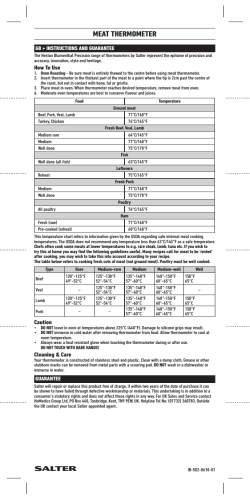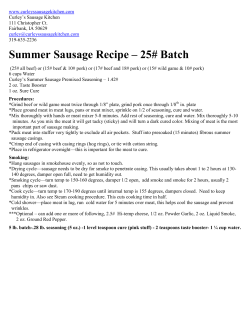
Document 159210
Ribs Ribs are meaty and flavorful, and are well suited for assertive spice rubs, especially ones with cumin, chile, brown sugar, and/or garlic. They require low temperatures and a leisurely pace for maximum tenderness and succulence. Slow-roasting Grill Slow-roasting makes This grilling technique ribs super-tender and fills uses indirect heat to slow your house with wonderful down the cooking process. aromas. To do it: Prepare a charTo do it: Heat the oven coal grill or heat the grill to to 375°F and place the medium-high. When hot, ribs meaty side up on a clean the grill with a wire rimmed baking sheet. brush and wipe down with Bake for 30-45 minutes, an oil-dipped paper towel. If you’re using a charcoal or until the outside starts to brown, and then reduce grill, bank the charcoals to heat to 250ºF. Continue to one side of the kettle. On a roast, basting periodically gas grill, reduce one of the with juices, until the meat burners to medium. is very tender and easily Put the ribs on the hot separates from the bone, part of the grill and cook, 2-4 hours. flipping every few minutes, until all sides are golden. Then move the ribs to the cooler part of the grill and continue to cook until the meat is very tender and starts to pull away from the bones, 2-4 hours. c comm unit y throu g h f oo d™ The Pork We Carry First and foremost, we want pork that tastes good and comes from a ranch that we can feel good about. Our must-have criteria for Pork are: • Animals are treated humanely and respectfully • Are only fed vegetarian feed • Never given hormones • Never treated with preventative antibiotics Nice-to-have criteria are: How to Cook POR K An Eat e r ’ s Gui de • Heritage breeds • Locally raised and processed • Pasture-raised The ranchers are just as important as the pigs themselves. We look for ranchers who operate small, family-based businesses and are stewards of the land. what is heritage pork? Over the last hundred years or so, ranchers have bred pigs to address the needs of commercial production as well as changing consumer preferences. In recent years, ranchers and consumers have taken a renewed interest in indigenous, “heritage” breeds. We love heritage pork because it boasts lots of marbling and intense flavor. Each heritage breed – from Red Wattle to Berkshire to the wooly Mangalitsa is distinct and special and delicious! re ng ati DELI MARKET C AT E R I N G 3639 18th St (at Dolores) San Francisco, CA 94110 415-241-9760 * biritemarket.com DELI MARKET C AT E R I N G f Visit our blog for more recipes & stories from our producers: biritemarket.com/blog Pork Loin Chops, Shoulder Chops & Tenderloins These cuts cook quickly and lend themselves to many different flavors and cuisines. Stovetop General Tips When cooking meat, the hardest thing to predict is when it will be done. It depends on a lot of factors: how thoroughly you like your meat cooked, the size and shape of the meat, the cooking method, how hot your flame is, and whether your oven holds a steady temperature. Practice is the best teacher. Touching, observing and monitoring at each stage from purchasing to eating helps you become more in-tune with your ingredients and the cooking process. Tips for Cooking Pork • Let large cuts come to room temperature before cooking. • For best browning, pat meat dry just prior to cooking, and avoid overcrowding the pan. • Season meat well with salt and pepper just before cooking. Marinades and dry rubs are a great way to add flavor. • Lubricate your cooking surface. Use a neutral oil such as canola, vegetable, grape seed, or a pure olive oil. Duck fat and lard also work well. Bacon fat is best! • An instant-read thermometer is your best friend when it comes to cooking meat. Insert it into the thickest part of the meat for the most accurate reading. (We sell them in the store, and for less than $10 each, it’s a worthwhile investment.) • Roasts or other cuts to be served sliced should rest, loosely tented in foil, for 10-15 minutes prior to slicing; this helps the meat stay juicy. Slice across the grain if possible. It’s easier to see the grain’s striations when the meat is still raw – so take a close look before you start cooking. Stovetop cooking is best suited to pork chops – tenderloins can be awkward to fit into a skillet unless you cut them in half. To do it: Season meat well. Heat 1-2 Tbs. oil or fat in a skillet over mediumhigh heat. When the oil is shimmering hot, add the chops and let cook undisturbed for at least 2 minutes. Then check the progress of the browning - if it sticks, it probably needs more time. When golden brown, flip and cook to desired doneness. If the meat is browning too quickly, reduce the heat and/or finish cooking in a preheated 350°F oven. Loin Roasts The loin is the same muscle found in our pork loin chops, and can come as a boneless roast or a bone-in rack. Sear-roast Broil Broiling gives you a little color on the surface of the pork without having to tend a skillet. In broiling, the heat source is situated over (and fairly close to) whatever is being cooked. To do it: If your broiler element is in the top of the oven, position a rack 4-6” from the element. Heat the broiler. Rub the meat with a little oil and season it well. Put the meat on a baking sheet, and put the pan under the broiler. When the first side is nicely colored, flip the pork and cook the other side. Be sure to keep an eye on it to avoid overcooking or burning! If it seems to be cooking too fast, lower the rack so that it’s a bit further from the heating element. Grill Grilling imparts complex, smoky flavors to pork chops and tenderloins. To do it: Prepare a charcoal grill or heat a gas grill to medium-high. When hot, clean the grate with a wire brush and wipe down with an oil-dipped paper towel. Season the meat and then grill 4-8 minutes per side, depending on the thickness of the meat and how well you want it done. Starting the cooking on the stovetop gives the pork a nice golden color – and finishing in the oven ensures a gentle, even cooking all the way through. To do it: Heat your oven to 350°F. Season meat well. Heat 1-2 Tbs. oil or fat in an oven-proof skillet over medium-high heat. When the oil is shimmering hot, add the meat (skin-side down, if applicable) and let cook undisturbed for at least 2 minutes. Then check the progress of the browning – if it sticks, it probably needs more time. When golden brown, turn and repeat until all sides are browned. Then transfer the skillet to the oven and roast, checking the temperature every 5-10 minutes, until the meat reaches the desired doneness. Roast Roasting is the ultimate in hands-off cooking. To do it: Heat your oven to 350°F. Season pork well and place on a rimmed baking sheet - bone-side down if it’s bone-in. Bake until cooked through, anywhere from 20 minutes to 1 hour; larger or bone-in roasts will be on the longer end of the range. Brining is a great way to add flavor to pork and ensure juiciness. To make a simple brine, combine 8 cups of water, ½ cup kosher salt, and ¼ cup sugar and stir until dissolved. Add pork (and any additional herbs, if desired) and refrigerate 30 minutes and up to 4 hours. Drain and pat pork dry before cooking. Timing guidelines for larger roasts* medium 18-20 minutes/lb. medium-well 20-25 minutes/lb. Well-done 25-30 minutes/lb. *(2 lbs. or more) PORK COOKING TEMPERATURES Pork is generally safe to eat when it’s still slightly pink in the center, and it’s how we prefer it! Fatty cuts like shanks and shoulders can be cooked to higher temperatures without risking drying out. 130-140°F – medium (just pink in center) 140-150°F – medium-well 150-155°F – well
© Copyright 2025













